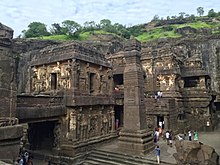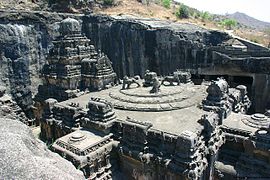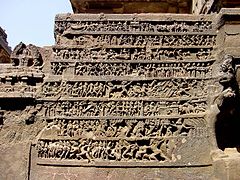Kailasa Temple, Ellora
| Kailasa Temple | |
|---|---|
Rashtrakuta Empire | |
| Completed | 8th century C.E |

The Kailasha (
The Kailasa temple (Cave 16) is the largest of the 34

History
Kailasa (Kaliash) temple lacks a dedicatory
- The
- The Kadaba grant of Govinda Prabhutavarsha similarly appears to credit Krishnaraja with the construction of the temple.[7]
However, the attribution of the temple to Krishna I is not completely certain because these epigraphs are not physically connected to the caves, and do not date Krishnaraja's reign.[8] Moreover, the land grants issued by Krishna's successors do not contain any references to the Kailasa temple .[9]
The Kailasa temple features the use of multiple distinct architectural and sculptural styles. This, combined with its relatively large size, has led some scholars to believe that its construction spanned the reigns of multiple kings.
Pallava-Chalukya influence
Dhavalikar pointed out that no major part of the monolithic temple appears to have been an afterthought: architectural evidence suggests that the entire temple was planned at the beginning.
If one assumes that the architects of the Virupaksha temple helped construct the Kailasa temple at Ellora, the construction of a massive temple during the reign of a single monarch does not seem impossible. The architects already had a blueprint and a prototype, which must have significantly reduced the effort involved in constructing a new temple. Moreover, quarrying a monolithic temple would have actually involved less effort than transporting large stones to build a new temple of similar size. Assuming that one person can cut around 4 cubic feet of rock every day, Dhavalikar estimated that 250 labourers would have managed to construct the Kailasa temple at Ellora within 5.5 years.[20] The presence of non-Rashtrakuta styles in the temple can be attributed to the involvement of Chalukya and Pallava artists.[22]
Construction method

The Kailasa Temple is notable for its vertical excavation—carvers started at the top of the original rock and excavated downward. The traditional methods were rigidly followed by the master architect which could not have been achieved by excavating from the front.[23]
A
Architecture
The Kailasa temple architecture is different from the earlier style prevalent in the
The entrance to the temple courtyard features a low
Within the courtyard, there is a central shrine dedicated to
-
Front view
-
Shikhara
-
Mandapa roof
-
Arcades
-
Ramayana panel
-
Mahabharata panel
-
Ravananugraha relief
There are five detached shrines in the temple premises; three of these are dedicated to the river goddesses:
There are two
In art and literature
![]() The Kylas, Caves of Ellora. is a poetical illustration by Letitia Elizabeth Landon based on an engraving of a painting by Samuel Prout published in Fisher's Drawing Room Scrap Book, 1833. This includes observations on the temple by Lord Munster from his Overland Journey from India.
The Kylas, Caves of Ellora. is a poetical illustration by Letitia Elizabeth Landon based on an engraving of a painting by Samuel Prout published in Fisher's Drawing Room Scrap Book, 1833. This includes observations on the temple by Lord Munster from his Overland Journey from India.
See also
- List of colossal sculpture in situ
References
- ^ a b c d e f "Section II: Periodic Report on the State of Conservation of Ellora Caves, India, 2003" (PDF). UNESCO. Retrieved 6 March 2016.
- ^ Michell, 362
- ^ Michell, 365
- ^ "Ellora's Kailasa Temple: Built from the Top". www.livehistoryindia.com. Archived from the original on 27 February 2021. Retrieved 23 March 2021.
- ^ Michell, 357
- ^ Michell, 362–366
- ^ a b c Deepak Kannal 1996, p. 101.
- ^ a b c Lisa Owen 2012, p. 135.
- ^ a b Lisa Owen 2012, p. 136.
- ^ H. Goetz 1952, p. 86.
- ^ a b M. K. Dhavalikar 1982, p. 33.
- ^ H. Goetz 1952, p. 89.
- ^ H. Goetz 1952, p. 106.
- ^ H. Goetz 1952, p. 92.
- ^ a b H. Goetz 1952, p. 107.
- ^ M. K. Dhavalikar 1982, p. 42.
- ^ M. K. Dhavalikar 1982, p. 39-40.
- ^ M. K. Dhavalikar 1982, p. 41.
- ^ M. K. Dhavalikar 1982, p. 44.
- ^ a b M. K. Dhavalikar 1982, p. 35.
- ^ M. K. Dhavalikar 1982, pp. 37–38.
- ^ M. K. Dhavalikar 1982, pp. 38–39.
- ISBN 81-7039-218-7.
- ISBN 978-81-7305-270-5.
- ^ M. K. Dhavalikar 1982, p. 42-43.
- ^ Deepak Kannal 1996, p. 102.
- ^ M. K. Dhavalikar 1982, pp. 38–40.
- ^ Deepak Kannal 1996, p. 108.
- ISBN 978-81-237-5255-6.
- ^ M. K. Dhavalikar 2003, p. 56.
Bibliography
- ISBN 9788185016474.
- JSTOR 3248615.
- Michell, George, The Penguin Guide to the Monuments of India, Volume 1: Buddhist, Jain, Hindu, 1990, Penguin Books, ISBN 0140081445
- Lisa Owen (2012). Carving Devotion in the Jain Caves at Ellora. BRILL. ISBN 978-90-04-20629-8.
- JSTOR 42931407.
- ISBN 978-0-19-565458-5.










